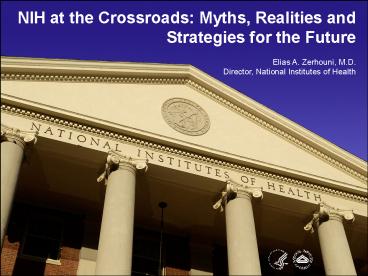Zerhouni NIH at the Crossroads PRAC 05222006 - PowerPoint PPT Presentation
1 / 24
Title:
Zerhouni NIH at the Crossroads PRAC 05222006
Description:
Physical Sciences focus. Biomedical research inflation- 3 to 5% NIH Budget: Myths and Realities... Is NIH placing more emphasis on applied as opposed to ... – PowerPoint PPT presentation
Number of Views:48
Avg rating:3.0/5.0
Title: Zerhouni NIH at the Crossroads PRAC 05222006
1
NIH at the Crossroads Myths, Realities and
Strategies for the Future Elias A. Zerhouni,
M.D. Director, National Institutes of Health
2
NIH Budget Facing a Perfect Storm in 2006
- Federal Trade Deficits
- Defense and Homeland Security needs
- Katrina
- Pandemic flu
- Post- Doubling effects
- Physical Sciences focus
- Biomedical research inflation- 3 to 5
3
NIH Budget Myths and Realities
4
What is Driving Success Rates?
- Is NIH placing more emphasis on applied as
opposed to basic science - Is NIH shifting towards solicited research (RFAs
and PAs) at the expense of unsolicited,
investigator-initiated research? - Is it due to the Roadmap?
5
Basic and Applied Research
60.0
56.4
55.8
55.2
55.2
55.2
53.9
56.6
52.1
56.1
53.0
50.0
43.5
41.0
40.8
40.5
41.0
39.8
39.2
40.0
40.8
38.5
38.4
30.0
20.0
10.0
7.0
5.7
5.0
5.5
5.2
4.8
3.7
3.1
3.1
3.6
0.0
FY 1998
FY 1999
FY 2000
FY 2001
FY 2002
FY 2003
FY 2004
FY 2005
FY 2006
FY 2007
Basic Research
Applied Research
Other
6
What is Driving Success Rates?
- Is NIH placing too much emphasis on translational
science at the expense of basic research? - Is NIH shifting towards solicited research (RFAs
and PAs) at the expense of unsolicited,
investigator-initiated research? - Is it due to the Roadmap?
7
Grants Unsolicited Far Outnumber Solicited
100
90
93
91
80
70
60
Percentage of Grants
Unsolicited
Solicited
50
40
30
20
10
0
1994
1996
1998
2000
2002
2004
2006
Fiscal Year
8
What is Driving Success Rates?
- Is NIH placing too much emphasis on translational
science at the expense of basic research? - Is NIH shifting towards solicited research (RFAs
and PAs) at the expense of unsolicited,
investigator-initiated research? - Is it due to the Roadmap?
9
NIH Roadmap for Medical Research
FY2005 Request 28,757M
- Developed to increase synergy across NIH
- Not a single initiative but over 345 individual
awards in FY05 - 40 basic
- 40 translational
- 20 high risk
Non-Roadmap 99.2 (28,520 Million)
Roadmap 0.8 (237 Million)
10
What Is Really Happening?3 Fundamental Drivers
- Large capacity building throughout U.S. research
institutions and increase in number of
tenure-track faculty - Large increase in applicants and applications
occurring after 2003 - Budgets
- Appropriations below inflation after 2003 ( 3
in 04, 2.2 in 05 and 0 in 06 ) while BRDPI in
2004 was 5 - Budget cycling phenomenon
11
New Grant Applications and Success Rates During
and After Doubling Period
35
60,000
49,656
30
31
50,000
43,069
25
40,000
Projected
22
20
Number of Applications
Success Rate of Grants Funded
30,000
19
24,154
15
20,000
10
10,000
5
0
0
1998
1999
2000
2001
2002
2003
2004
2005
2006
2007
Success Rates
Applications
12
As Many New Applicants in the Last 2 years as
during the previous 5 years!
13
The Budget Cycling PhenomenonWhat Funds are
Really Available in Any One Year?
From current year to previous year
Budget Increase
Uncommitted Funds
From ending grants started 4-5 years ago
Continuing grants
Committed Funds
NIH Appropriations
14
NIH Congressional Appropriations
30
28.6
28.6
28.6
28.0
27.1
25
?
23.3
20
20.5
17.8
15
Billions of Dollars
15.6
13.7
10
5
0
FY
FY
FY
FY
FY
FY
FY
FY
FY
FY
1998
1999
2000
2001
2002
2003
2004
2005
2006
2007
DOUBLING
15
The Bottom Line Demand for Grants Took Off
Just as NIH Budget Was Landing!
- NIH managed well in 2004 and 2005 by shifting
one time funds from 2003 to 2004, and obtaining
small increases in 2004 (2.9) and 2005 (2) - Katrina requirements led to a flat 2006 NIH while
rest of HHS underwent a 2.5 cut - Budget cycling effect will improve demand vs
supply of grants in 2007 but we need to educate
public about need for sustainability in research
16
The Question on Everyones MindWhat are MY
chances of being funded?
- Payline is not the funding cut-off line!
- Success rate per application understates funding
rate per applicant - FY 2005- 22.3 success rate for applications, but
27.6 for applicants - FY 2006- 19.8 for applications, but 25 for
applicants
17
Success Rate is Higher than the Percentile Payline
-
100
Percent R01s Funded
0
0
10
20
30
40
Percentile Score
18
Success Rates are always higher for Applicants
than for Applications
40
Applicant
35
30
25
Success Rate for R01 Equivalents
20
Applications
15
10
5
0
1995
1997
1999
2001
2003
2005
Fiscal Year
Success Rate files as of May 3, 2006. Program
srf_indiv_060103_rfm Individuals are determined
using the pi_profile_person_id in IMPAC-II
19
Where Do We Go From Here?Adaptive Strategies
A Vision for the Future
20
Strategies
- First Know the facts
- Second Develop adaptive strategies
- Protect the essential Knowledge and Discovery
- Increase number of competing grants
(supply/demand management) - Support new investigators
- New Pathway to Independence Program
- Institutes and Centers efforts to assist new
investigators - Third Convey a unified message
- Increase communications about positive impact of
NIH at local, regional and national levels - Fourth NIHs exciting vision for the future
21
CSRMaking Peer Review More Efficient
- Electronic Receipt
- Exploring ways to make peer review more efficient
for both applicants and reviewers - Pilot study to shorten the review cycle for new
investigator RO1 applications
22
Basic Discovery Today Provides the Foundation for
Tomorrows Medicine
Clinical Applications
Translational Research
Basic Research and Technology Development
23
The Future Paradigm Transform Medicine from
Curative to Preemptive
Predictive
Preemptive
Personalized
24
Transforming medicine through discovery
NIH






























